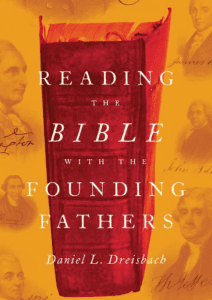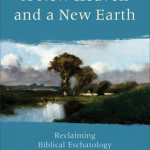 Any discussion of the interface of science and scripture will eventually come to Genesis 1-3 creation and fall. The centrality of this discussion was obvious in the comments after the post on Tuesday Pastors Unconvinced … Now What? and the brief post yesterday Science, Evolution, and the Bible. Dr. John Polkinghorne gives an overview of his approach to creation and fall in chapter three his book Testing Scripture: A Scientist Explores the Bible.
Any discussion of the interface of science and scripture will eventually come to Genesis 1-3 creation and fall. The centrality of this discussion was obvious in the comments after the post on Tuesday Pastors Unconvinced … Now What? and the brief post yesterday Science, Evolution, and the Bible. Dr. John Polkinghorne gives an overview of his approach to creation and fall in chapter three his book Testing Scripture: A Scientist Explores the Bible.
Dr. Polkinghorne, before he entered into the Anglican priesthood, was a very successful scientist, a theoretical physicist involved in the discovery of quarks and Professor of Mathematical Physics at Cambridge University. His view of the Christian faith takes the information learned through the scientific study of creation very seriously. We have, he finds, very good reason to believe that the universe is ~13.7 billion years old, having begun as an almost uniform expanding ball of energy. The earth developed out of this through the generation of stars producing heavier elements some 4.6 billion years ago. Life developed from single-celled organisms into the vast diversity of species we see today in a process that began something like 3.5 billion years ago (a rough estimate). Biological death was part of creation from the very origin of life itself.
How then does Dr. Polkinghorne approach Genesis 1-3 and Romans 5?
Creation in Scripture. Dr. Polkinghorne sees the two stories of creation in Genesis 1 and 2, especially Genesis 2, as true myth – with a truth so deep that only story can convey it. To look at the context in which this story is told he starts with an observation I find particularly important.
[T]he fact that these two stories themselves are incompatible with each other should warn us against treating them as if they were divinely dictated accounts, given to save us the trouble of scientific investigation into terrestrial and cosmic history. (p. 22)
In reading and interpreting scripture we must consider the form, genre, context, and purpose of the text. Genesis 1-2 serves several purposes – but a scientific presentation of the origin of the universe, the earth, and life is not one of these purposes. The questions brought to the table by modern science were out of context in the ancient Near East in general.
For example, Genesis 1 does not give us a quasi-scientific account of a hectic six days of divine activity, but is something altogether deeper and more interesting than that. It is a theological text whose principle purpose is to assert that nothing exists except through the will of God. (p. 22)
A key point in Genesis 1 is that even the sun, moon, and stars are nothing more than things created by God – they are not gods or beings. God alone is creator and God alone is sovereign. Genesis 2 is also a theological text.
This second chapter of Genesis offers important theological insights by means of the story it tells: humanity’s place within nature as God forms Adam from the dust of the earth; the presence, nevertheless, of a transcendent dimension in human life as God inspires Adam with the breath of life; (p. 23)
These stories undermine the deities of the surrounding peoples, establish humans as creates as God’s image rather than as slaves of a divine pantheon, and provide a sense of mission and purpose that then moves forward in the story of scripture. The creation stories told in Genesis 1-2 show the influence of their time and culture – but they carry through to the present in a way that rings true with a truth we can understand and appreciate. In contrast the ancient Near Eastern myths, for example the Babylonian story Enuma Elish, with the world created following a battle between Marduk and Tiamath, are far more foreign.
Dr. Polkinghorne also turns to Proverbs, Psalms, and especially Job as he considers the way creation is handled in scripture. In Job 38-41 the Lord responds to Job by taking him on a tour of the wonders of creation. Following this tour Job responds in humility and worship.
He replies. ‘I have heard of you by the hearing of the ear, but now my eye sees you; therefore I despise myself and repent in dust and ashes’ (Job 42.5-6). The whole of nature is to be seen as a theophany, a revelation of the Creator. (p. 27)
The ancient creeds of the church begin “I believe in [one] God, the father almighty, creator of heaven and earth.” This is the essence of the creation story and a foundational given in Christian belief.
 But what about the Fall in Genesis 3? Dr. Polkinghorne reads Genesis 3 returning to the idea of true myth.
But what about the Fall in Genesis 3? Dr. Polkinghorne reads Genesis 3 returning to the idea of true myth.
I do not believe that the chapter is the historical account of a single disastrous ancestral act, but it is a story conveying truth about the relationship between God and humanity. … Once the story’s mythic power is released from bondage to a fundamentalist reading, it becomes full of insight of a kind that can be seen as complementary to the insights afforded us by science. (p. 28)
He goes on to outline his interpretation of the story of the Fall. Human beings are self-conscious and self-aware, with the ability to comprehend both past and present. This exceeds the abilities and awareness of any animal.
The chimpanzee can figure out that if he throws up a stick, the banana may fall down, but he does not sit there brooding on the fact that in ten or twenty years’ time he will be dead. Human beings, on the contrary, do live aware that they will die, even when the event is likely to be many years away. (p. 29)
In a way somewhat reminiscent of the view put forth by CS Lewis in The Problem of Pain, the gradual process of developing self-awareness was “accompanied by a dawning consciousness of the presence of God (the formation of the imago dei).” But among these people, aware of self and of God, there was a turning away from God to focus on human self, to become like God, knowing good and evil. There may not have been a snake, a tree, and a piece of fruit, but there was a Fall.
The Fall is indeed a fall ‘upward’, the gaining of knowledge, but it is an error to suppose that humans can thereby attain equality with their Creator, so that they can live their lives independently of God. This declaration of complete human autonomy, the assertion that we can simply ‘do it my way’ is the root meaning of sin. The refusal to acknowledge that we are creatures in need of the grace of our Creator is the source of subsequent human sins, those deeds of selfishness and deceit that mar our lives as the result of believing the false claim to be completely independent of the assistance of divine grace. (p. 29-30)
The Fall involved alienation from God and from his purposes. It did not bring death, which is an intrinsic part of life in this present creation, but it did bring mortality and despair. God’s “steadfast faithfulness is the only (and sufficient) true ground for the hope of a destiny beyond death.” Alienation from God removed this ground for hope. Alienation from God damages relationships between people.
Dr. Polkinghorne finds that this understanding of creation and fall brings illumination to Romans 5. Paul may have viewed Adam as an individual, but we can view Adam as a collective symbol for humanity. The message remains the same. Death came through sin and alienation. Life comes through Christ.
Alienation from God brought the bitterness of mortality, but the relation of humanity to God has been restored in the atonement (at-one-ment) brought by Jesus Christ, in whom the life of humanity and the life of divinity are both present and the broken link is mended. (p. 30)
The only view removed from the table by Dr. Polkinghorne’s understanding of Genesis 3 and Romans 5 and his understanding origins derived from science is the idea that biological death and disease, thorns, thistles, claws, canine teeth, and parasites, were foreign to the creation God declared good. The apparent imperfection of the “natural” world cannot be explained by appealing to human sin. He returns to this issue in a later chapter of the book and we will come back to it then.
What do you think – does Dr. Polkinghorne’s interpretation of the biblical witness to creation and fall make sense?
Where do you agree or disagree?
The new book by Pete Enns, The Evolution of Adam: What the Bible Does and Doesn’t Say about Human Origins, looks specifically at the nature of the biblical texts on creation and fall from the perspective of an Old Testament scholar. I hope to begin a series on this book next week, perhaps as early as Tuesday.
If you wish to contact me directly you may do so at rjs4mail[at]att.net.
If interested you can subscribe to a full text feed of my posts at Musings on Science and Theology.











